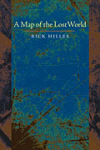A Map of the Lost World
A Map of the Lost World is literary blending of history and poetry through lyricism, realism, and, it would seem, an almost empathetic touch of irony that leaves the reader caught between literary landscape planes. The book is comprised of five parts (each of the parts and each of the poems, by the way, with utterly fantastic titles) that do not necessarily work to frame a specific narrative whole, yet they nevertheless contribute to A Map of the Lost World in specific ways. What author Rick Hilles does, then, is weave together the particular commonalities between these parts: unexpected geographies, small moments, specific people, connected anecdotes, stories, transliterated language. The real literary strength of Hilles’s writing comes from his broad familiarity with historical themes and his ability to connect individuals—and his readers—to those themes.
A Map of the Lost World is literary blending of history and poetry through lyricism, realism, and, it would seem, an almost empathetic touch of irony that leaves the reader caught between literary landscape planes. The book is comprised of five parts (each of the parts and each of the poems, by the way, with utterly fantastic titles) that do not necessarily work to frame a specific narrative whole, yet they nevertheless contribute to A Map of the Lost World in specific ways. What author Rick Hilles does, then, is weave together the particular commonalities between these parts: unexpected geographies, small moments, specific people, connected anecdotes, stories, transliterated language. The real literary strength of Hilles’s writing comes from his broad familiarity with historical themes and his ability to connect individuals—and his readers—to those themes.
Unquestionably, the strongest piece that appears in A Map of the Lost World is “The Red Scarf & the Black Briefcase,” which Hilles describes as being written in the voice of Lisa Fittko, a World War II Jewish Resistance fighter. Drawing material from her two memoirs, Hilles sketches the 1940 flight of the German Jewish philosopher Walter Benjamin and his “Black Briefcase.” After Fittko leads Benjamin through the Pyrenees and safely to Spain, he is arrested by Spanish authorities and (apparently) commits suicide. Fittko comforts herself, however, that the black briefcase has made it safely to its destination—only to be told that it was never received:
It’s easy enough to romanticize the contents
of Benjamin’s black briefcase. What I recall most
about the weather-beaten bag? It had the mind
of a goat and the heft of a friar passed out on
communion wine, impervious to our best efforts
to assure its safety. I remember the black case
becoming heavier and heavier in our ascent, as if
its owner were mentally adding pages as we scaled
our way to the Spanish coast. Behind us, to the North,
la Côte Vermeille, Vermillion Coast, of Catalonia’s
Roussillon, innumerable yellow-golds and reds.
I’d never seen such beauty; I gasped. It seemed
unfair to have to turn back to occupied France
while der alte Benjamin and his entourage departed
for what we hoped would be their lasting escape.
The loss of this bag—poetically, the loss of Benjamin as a philosopher—was what Hilles quotes Bertolt Brecht as calling “the first real blow that Hitler had dealt German letters.” We, as readers, see Hilles building a complex and brilliantly multi-layered symbolic character and object.
We also see the poignant parallelism in Lisa Fittko’s “Red Scarf”—where she flaunts her red scarf as a symbol of her Resistance and steadfastness in her cause. The red scarf slowly morphs into her character counterpart to the black briefcase:
Sometimes my memory puzzles me. It conjures
a red blouse on a clothesline, opening in the wind.
The fluted, Corinthian columns of the arms come alive
like a sleepwalker almost waking
from an unbearable dream. The breeze breathes through
the well-worn, translucent satin,
flexing and releasing.
Both characters wear their symbols—they are their own symbols; they become inseparable from them—and the author’s fluidity with language and transliteration pulls the reader into their story and history. Through the story of Lisa Fittko and Walter Benjamin, set broadly within that of World War II, Rick Hilles is able to write carefully, specifically, and compellingly about the relationship between history and the individual human condition.
At the end of A Map of the Lost World, Hilles includes notes and his thoughts about the context for the poems that are included with the collection. I would suggest reading these notes first, before the poems—or at least in parallel with the pieces. One’s understanding is deepened by the context. Although A Map of the Lost World does not stand out with particular coherence as a grouping of poems thematically or narratively, it does nevertheless work to infuse history with a literary sense. And, in the case of “The Red Scarf & the Black Briefcase,” we see Hilles’s brilliant talent for complex symbolism, parallelism, and a detached, almost ironic—yet empathetic—narrative voice.





